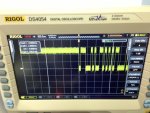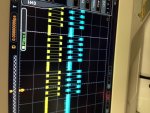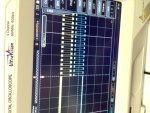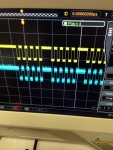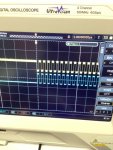Hi all,
I have built a network of picaxe 14M chips that communicate between each other through a MAX487 RS485 chip.
They all work nicely and I can "see" the messages being sent and received using a terminal program.
However, when I use a PC to send an instruction through the 485 bus, the Picaxe chips don't respond.
So I thought this was a timing issue, and took out my nice new oscilloscope to investigate...... Well it seems that the timing is correct, but there is a difference that appears between characters..... Attached are two images. Image "3" is the picaxe sending a "GVC" ascii string, and "4" is the PC sending the same string. There are differences every 8 bits. Is this a timing issue between letters?
I have built a network of picaxe 14M chips that communicate between each other through a MAX487 RS485 chip.
They all work nicely and I can "see" the messages being sent and received using a terminal program.
However, when I use a PC to send an instruction through the 485 bus, the Picaxe chips don't respond.
So I thought this was a timing issue, and took out my nice new oscilloscope to investigate...... Well it seems that the timing is correct, but there is a difference that appears between characters..... Attached are two images. Image "3" is the picaxe sending a "GVC" ascii string, and "4" is the PC sending the same string. There are differences every 8 bits. Is this a timing issue between letters?
Attachments
-
136.6 KB Views: 45
-
124.7 KB Views: 37


